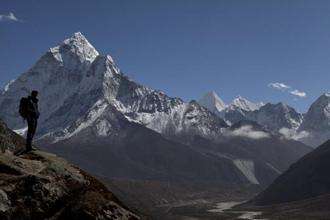November 11, 2015
New Delhi: A team of scientists have identified the year of birth of the Himalayas, which happened because of the collision of the India and Eurasian plates, after discovering the first oceanic micro plate in the Indian Ocean.

A file photo of the way to the Everest Base camp, above Pheriche valley, Nepal, in the Himalayas. Photo: AP
November 11, 2015
New Delhi: A team of scientists have identified the year of birth of the Himalayas, which happened because of the collision of the India and Eurasian plates, after discovering the first oceanic micro plate in the Indian Ocean.

A file photo of the way to the Everest Base camp, above Pheriche valley, Nepal, in the Himalayas. Photo: AP
This is the first ancient Indian Ocean microplate to be discovered.
This micro plate named by researchers as Mammerickx Microplate, could put an end to the debate regarding the exact year of the birth of the Himalayas. Using radar beam images from a satellite, scientists were able to put the pieces of the plate together to find out the age of the collision. In the journal Earth and Planetary Science Letters, the team of scientists says the collision between India and Eurasia took place 47 million years ago.
“The age of the largest continental collision on Earth has long been controversial, with age-estimates ranging from at least 59 to 34 million years ago,” said lead author Kara Matthews from the University of Sydney in a press release. “Knowing this age is particularly important for understanding the link between the growth of mountain belts and major climate change,” added Matthews.
The continuing tectonic collision between the two India and Eurasia leads to numerous earthquakes every year—but this study shows how stressed the Indian Plate became when its northern edge first smash together with Eurasia. Study says that 50 million years ago, India was travelling northwards at speeds of some 15 centimetres a year and soon collided with Eurasia crustal stresses along the mid-ocean ridge between India and Antarctica. A piece of Antarctica’s crust separated and formed the newly discovered tectonic plate.
“Roughly 90% of the seafloor is uncharted by ships and it would take 200 ship-years of time to make a complete survey of the deep ocean outside continental shelves, at a cost of between two to three billion US dollars,” said David Sandwell from the Scripps Institution of Oceanography. “That’s why advances in comparatively low-cost satellite technology are the key to charting the deep, relatively unknown abyssal plains, at the bottom of the ocean,” he added.
Courtesy: Live Mint







































































































